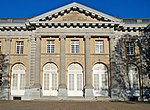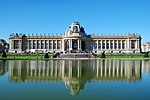Royal Museum for Central Africa

The Royal Museum for Central Africa or RMCA (Dutch: Koninklijk Museum voor Midden-Afrika or KMMA; French: Musée royal de l'Afrique centrale or MRAC; German: Königliches Museum für Zentralafrika or KMZA), also officially known as the AfricaMuseum, is an ethnography and natural history museum situated in Tervuren in Flemish Brabant, Belgium, just outside Brussels. It was built to showcase King Leopold II's Congo Free State in the International Exposition of 1897. The museum focuses on the Congo, a former Belgian colony. The sphere of interest, however, especially in biological research, extends to the whole Congo River basin, Middle Africa, East Africa, and West Africa, attempting to integrate "Africa" as a whole. Intended originally as a colonial museum, from 1960 onwards it has focused more on ethnography and anthropology. Like most museums, it houses a research department in addition to its public exhibit department. Not all research pertains to Africa (e.g. research on the archaeozoology of Sagalassos, Turkey). Some researchers have strong ties with the Royal Belgian Institute of Natural Sciences. In November 2013, the museum closed for extensive renovation work, including the construction of new exhibition space, and re-opened in December 2018 under its new name.
Excerpt from the Wikipedia article Royal Museum for Central Africa (License: CC BY-SA 3.0, Authors, Images).Royal Museum for Central Africa
Leuvensesteenweg,
Geographical coordinates (GPS) Address Phone number Website External links Nearby Places Show on map
Geographical coordinates (GPS)
| Latitude | Longitude |
|---|---|
| N 50.830888888889 ° | E 4.5184972222222 ° |
Address
AfricaMuseum
Leuvensesteenweg 13
3080 (Tervuren)
Flemish Brabant, Belgium
Open on Google Maps







